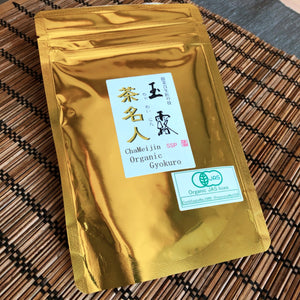Gyokuro 'Chameijin'
Tax included
Shipping calculated at checkout
Out of stock
Pickup currently unavailable
Gyokuro 'Chameijin' - Sakamoto Family, Shibushi (Kagoshima)
Chameijin (茶名人 – “tea master”) is Mr. Sakamoto’s popular gyokuro: dense, sweet umami, clean, creamy mouthfeel and long-lasting, soft sweetness. A shade-grown (approx. 20–21 days), organically grown tea, it is exceptionally rich and balanced thanks to Sakamoto’s natural, bokashi -based nutrient management and careful processing.
Origin & processing
- Producer: Sakamoto family (Shibushi, Kagoshima, Southern Japan)
- Cultivation: organic approach, self-developed natural fertilization
- Shade: about 20–21 days before picking for high amino acid and umami content
- Cultivar: may vary depending on the vintage (Saemidori is common); current batch information is on the packaging
- Steaming: gentle, to preserve the leaf structure and silky flesh
Taste and aroma profile
- Aroma: sweet-salty umami, nori/kombu, fresh steamed greens
- Taste: silky, soupy (dashi), cooked spinach and edamame, almond-cashew creaminess, a hint of sweet milk caramel
- Aftertaste: long, clean, sweet-mineral finish
- Body: full, oily-creamy mouthfeel, high concentration
When do we recommend it?
A gyokuro that invites you to pause and focus – for quiet afternoons, tastings, or a celebratory, “slow” tea ceremony. It shows its best when used with shiboridashi/hohin as part of the tea ceremony ritual.
Preparation instructions
Gyokuro (shiboridashi/hohin) - "essence" style
- Tool: shiboridashi/hohin 60–100 ml
- Tea: 6–8 g
- Water: 50–60 °C, very soft water recommended
- 1st pour: 90–120 seconds (do not stir, just pour carefully)
- Additional pours: 15–30 seconds, gradually increasing the water temperature to 60–65 °C
- Result: extremely dense, sweet-umami, silky texture
“Sencha-style” (as everyday gyokuro)
- Equipment: Japanese jug 250–300 ml
- Tea: 3–4 g
- Water: 65–70 °C
- 1st pour: 60–90 sec; 2nd–3rd pour: 30–45 sec
- Result: a softer, fresh-green complexion, yet rich in umami
Cooling methods
- Kōridashi (ice drip): Place 6–8 g of tea in the strainer, cover with ice cubes and let it drip; in 20–40 minutes you will get a thick, deeply sweet extract
- Mizudashi (cold steep): 8–10 g/l, 6–8 hours in the refrigerator; clear, silky, low bitterness drink
Tips & pairing
- Water: soft, low-mineral water works best
- Food pairing: lightly salty snacks (e.g. nori, toasted seeds), sashimi, fresh goat cheese
- Storage: cool, protected from light and odors, airtight; after opening, it is advisable to keep refrigerated
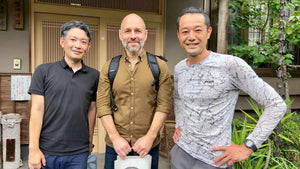
Personal contact
Our teas don't come from wholesale warehouses or unknown sources. We travel to the small producers we source from – whether it's a Japanese family tea garden, a Chinese mountain village or an oolong maker in Taiwan.
Stories
We meet them in person, learn their story, see how they care for their plants, and how they process the fresh leaves.
These experiences are the soul of our teas. This way, not only is the quality guaranteed, but also the fact that behind each cup there is a real person, a real story.
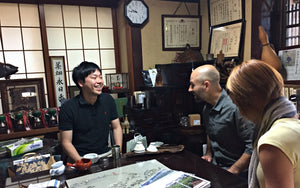
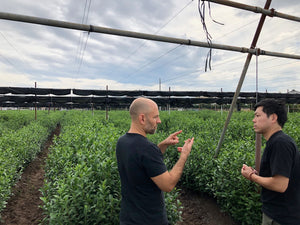
Direct
This direct relationship is valuable to us. Not only because of the excellent tea, but because we believe that trust, respect and personal presence are what make the tea drinking experience truly special.
Teavolution Tea Blog
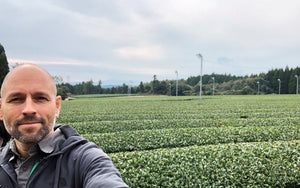
Oct 2, 2025
Sencha tea
Read more

Sep 21, 2025
Matcha hiány Japánban
Read more
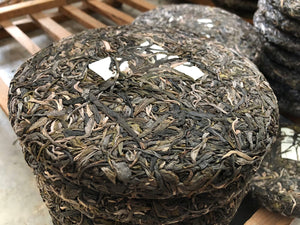
Mar 18, 2025
Puer tea, puerh or pu-erh
Read more
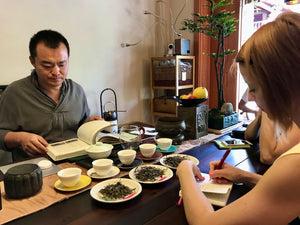
Mar 18, 2025
Types of tea
Read more
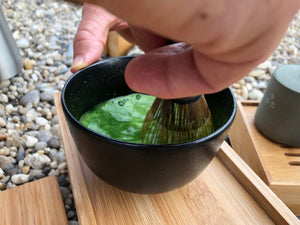
Mar 18, 2025
What is matcha tea?
Read more

Mar 18, 2025
Oolong tea (Wulong tea)
Read more

